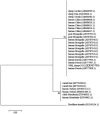Genotype and Phenotype of Echinococcus granulosus Derived from Wild Sheep (Ovis orientalis) in Iran
- PMID: 26951979
- PMCID: PMC4792325
- DOI: 10.3347/kjp.2016.54.1.55
Genotype and Phenotype of Echinococcus granulosus Derived from Wild Sheep (Ovis orientalis) in Iran
Abstract
The aim of the present study is to determine the characteristics of genotype and phenotype of Echinococcus granulosus derived from wild sheep and to compare them with the strains of E. granulosus sensu stricto (sheep-dog) and E. granulosus camel strain (camel-dog) in Iran. In Khojir National Park, near Tehran, Iran, a fertile hydatid cyst was recently found in the liver of a dead wild sheep (Ovis orientalis). The number of protoscolices (n=6,000) proved enough for an experimental infection in a dog. The characteristics of large and small hooks of metacestode were statistically determined as the sensu stricto strain but not the camel strain (P=0.5). To determine E. granulosus genotype, 20 adult worms of this type were collected from the infected dog. The second internal transcribed spacer (ITS2) of the nuclear ribosomal DNA (rDNA) and cytochrome c oxidase 1 subunit (COX1) of the mitochondrial DNA were amplified from individual adult worm by PCR. Subsequently, the PCR product was sequenced by Sanger method. The lengths of ITS2 and COX1 sequences were 378 and 857 bp, respectively, for all the sequenced samples. The amplified DNA sequences from both ribosomal and mitochondrial genes were highly similar (99% and 98%, respectively) to that of the ovine strain in the GenBank database. The results of the present study indicate that the morpho-molecular features and characteristics of E. granulosus in the Iranian wild sheep are the same as those of the sheep-dog E. granulosus sensu stricto strain.
Keywords: Echinococus granulosus; Iran; genotype; phenotype; wild sheep.
Conflict of interest statement
We have no conflict of interest related to this work.
Figures




Similar articles
-
Molecular characterization of human and animal Echinococcus granulosus isolates in Isfahan, Iran.Acta Trop. 2011 Jan;117(1):47-50. doi: 10.1016/j.actatropica.2010.09.002. Epub 2010 Sep 19. Acta Trop. 2011. PMID: 20858453
-
Comparative Genotyping of Echinococcus granulosus Infecting Livestock in Turkey and Iran.Turkiye Parazitol Derg. 2019 Sep 10;43(3):123-129. doi: 10.4274/tpd.galenos.2019.6117. Turkiye Parazitol Derg. 2019. PMID: 31502802
-
Genotyping Echinococcus granulosus from dogs from Western Iran.Exp Parasitol. 2012 Oct;132(2):308-12. doi: 10.1016/j.exppara.2012.07.010. Epub 2012 Aug 3. Exp Parasitol. 2012. PMID: 22884512
-
Phylogenetic analysis and genetic evaluation of the Echinococcus granulosus antigen B subunit 2 gene isolated from sheep in Al-Diwaniyah, Iraq.Open Vet J. 2025 Feb;15(2):1043-1049. doi: 10.5455/OVJ.2025.v15.i2.52. Epub 2025 Feb 28. Open Vet J. 2025. PMID: 40201827 Free PMC article. Review.
-
Echinococcus granulosus sensu lato Genotypes in Different Hosts Worldwide: A Systematic Review.Acta Parasitol. 2022 Mar;67(1):161-185. doi: 10.1007/s11686-021-00439-8. Epub 2021 Jul 15. Acta Parasitol. 2022. PMID: 34264444
Cited by
-
Echinococcus granulosus comparative genotyping in sheep in Saudi Arabia and Egypt.Open Vet J. 2024 Mar;14(3):866-878. doi: 10.5455/OVJ.2024.v14.i3.14. Epub 2024 Mar 31. Open Vet J. 2024. PMID: 38682137 Free PMC article.
-
Echinococcus species in wildlife.Int J Parasitol Parasites Wildl. 2024 Feb 8;23:100913. doi: 10.1016/j.ijppaw.2024.100913. eCollection 2024 Apr. Int J Parasitol Parasites Wildl. 2024. PMID: 38405672 Free PMC article. Review.
-
Prevalence and characterization of hydatidosis in Najdi sheep slaughtered in Riyadh city, Saudi Arabia.Saudi J Biol Sci. 2018 Nov;25(7):1375-1379. doi: 10.1016/j.sjbs.2018.04.011. Epub 2018 Apr 9. Saudi J Biol Sci. 2018. PMID: 30505184 Free PMC article.
-
Echinococcoses in Iran, Turkey, and Pakistan: Old Diseases in the New Millennium.Clin Microbiol Rev. 2021 Jun 16;34(3):e0029020. doi: 10.1128/CMR.00290-20. Epub 2021 Jun 2. Clin Microbiol Rev. 2021. PMID: 34076492 Free PMC article.
-
Genetic survey of cystic echinococcosis in farm animals in Oman.Trop Anim Health Prod. 2020 Jan;52(1):331-337. doi: 10.1007/s11250-019-02019-5. Epub 2019 Jul 23. Trop Anim Health Prod. 2020. PMID: 31338730
References
-
- Fasihi Harandi M, Hobbs RP, Adams PJ, Mobedi I, Morgan-Ryan UM, Thompson RCA. Molecular and morphological characterization of Echinococcus granulosus of human and animal origin in Iran. Parasitology. 2002;125:367–373. - PubMed
-
- Eslami A, Farsad-Hamdi S. Helminth parasites of wild boar, Sus scrofa, in Iran. J Wildl Dis. 1992;28:316–318. - PubMed
-
- Meshgi B, Eslami A, Bahonar AR, Kharazian-Moghadam M, Gerami-Sadeghian A. Prevalence of parasitic infections in the red fox (Vulpes vulpes) and golden jackal (Canis aureus) in Iran. Iran J Vet Res Shiraz Univ. 2002;10:387–391.
-
- Sadighian A. Helminth parasites of stray dogs and jackals in Shahsavar area, Caspian Sea region. J Parasitol. 1969;55:372–374. - PubMed
-
- Hosseini SH, Eslami A. Morphological and developmental characteristics of Echinococcus granulosus derived of sheep, cattle and camel in Iran. J Helminthol. 1998;72:337–341. - PubMed
Publication types
MeSH terms
Substances
LinkOut - more resources
Full Text Sources
Other Literature Sources

